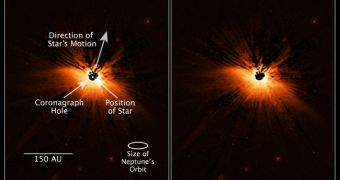It seems that the shape of the evolving young solar system, forming a 35.2 billion kilometer structure in the form of a moth, is determined by the relative motion of the young stars through the interstellar space. As it is traveling through space, the developing solar system encountered a massive cloud of interstellar dust, which causes the distortions in the protoplanetary disk, as it is being dragged behind the star.
The Sun-like system dubbed HD 61005, recently discovered by the Hubble Space Optical Telescope, lies only 100 light years away from our solar system, and was detected during a survey of the sky in order to find other nearby Sun-like stars that might present a planetary system formation process.
The particular discovery of the HD 61005 system came as a routine finding, but the shape of the protoplanetary disk raised some serious questions about the density of the interstellar material in the near vicinity of our solar system. Scientists previously thought that the interstellar medium has a lower density, due to gas dispersion processes which would usually take place as a result of supernovae explosion aftershock.
It is currently known that at least one supernova explosion could have taken place in the last few million years, so the gas density around the solar system was expected to be lower. It is currently uncertain how such a disturbing effect would affect the process of planetary formation, but astrophysicists argue that these interactions would mostly impact the evolution of the planets' atmospheres.
The Hubble Telescope revealed that the distorted disk of matter spinning around stars such as HD 61005, which is about 100 million years old, usually takes a flat form. Furthermore, the protoplanetary disk has been greatly affected by intense radiation levels emitted from the Trapezium stars in the Orion Nebula.
Combined observations from the Spitzer and Hubble Space Telescopes will probably reveal more about the composition of the protoplanetary disk, whether it is composed of dust in icy or sandy state, and the sizes of objects developing inside it, information that would provide with new examples regarding the dynamics and evolution of the solar system.

 14 DAY TRIAL //
14 DAY TRIAL //